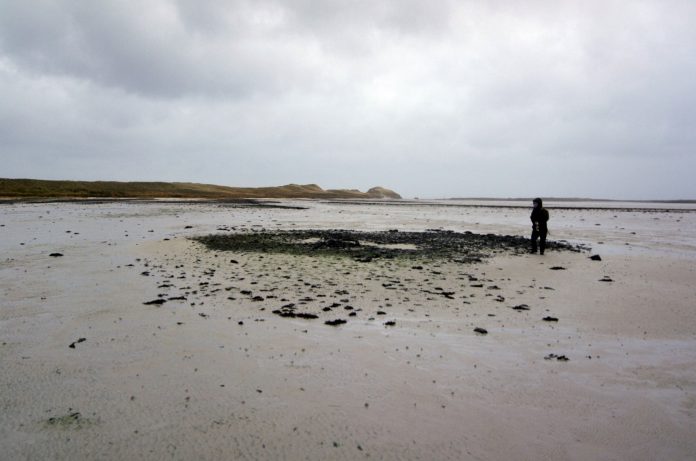Archaeological discoveries are often made when least expected, and this is exactly what happened last Monday 7th December at Tresness, Sanday. In very poor weather, Prof. Jane Downes (University of the Highlands and Islands), Prof. Colin Richards (University of Manchester), Dr Vicki Cummings (University of Central Lancashire) and Christopher Gee (ORCA, UHI) were walking out to Tresness to examine the eroding stalled cairn on the point.
Initially, Christopher noticed what appeared to be the top of a substantial cairn of stones emerging through the sand. Then, Jane and Vicki spotted a circular spread of stones lying nearby in the intertidal zone on the western side of the ness. Investigating the spread, a large number of ard-points, stone mattocks, stone bars, hammerstones and stone flaked knives were immediately visible on the surface. Closer examination revealed sections of stone walls and uprights, which were clearly part of a house structure. No sooner was the spread of stones identified as the remains of a Bronze Age house, when another spread of stones was seen lying just a few metres away. This too was another house structure covered with a mass of stone tools. As the group continued walking along the sand, one after another, a series of Bronze Age sites were discovered.
The houses are visible as differently shaped spreads of stones, and in all some 14 examples were located distributed over a kilometre stretch along the sand. This vast spread of Bronze Age settlement appears to have been sealed beneath the massive sand-dunes that characterise the approach to Tresness. Indeed, a number are actually in the process of eroding from beneath the dune complex. What this discovery reveals is that an entire Bronze Age landscape on Sanday was covered by the sand dunes formed in the second millennium BC. It was the scale and density of occupation that really surprised the archaeologists as they proceeded along the ness. Not only are house structures present but working areas are also visible. Prof. Downes, who specialises in the Bronze Age was stunned by the extent of the settlement area, “this must be one of the biggest complexes of Bronze Age settlement in the Scottish isles, rivalling the spreads of hut circles in other parts of mainland Scotland”, she exclaimed.
The Bronze Age, in terms of settlement and associated agricultural practices, is probably the least understood period in Orcadian prehistory, and the vast quantity of ard-points testifies to the dominance of arable agriculture occurring at this time. It also confirms the strange practice of depositing numerous ard-points and stone tools in houses after they were ‘decommissioned’ noted by Prof. Downes. Similar Bronze Age houses have been recently excavated at the Links of Noltland, Westray; however, the scale of the Sanday discoveries is unparalleled in Orkney. Cath Parker, leader of the Sanday Archaeology Group, says “This is incredibly exciting. The archaeological landscape concealed beneath Sanday’s shifting sands never ceases to amaze us. I’m sure the local community will relish the opportunity to be involved with any work which stems from this thrilling discovery.”
This new discovery offers the possibility of examining a dispersed Bronze Age settlement context in detail; an occurrence that will surely shed new light on this rather hazy period in Orcadian prehistory. Prof. Richards noted that “after a long history of excavating the large late Neolithic settlements or ‘villages’, most recently the Ness of Brodgar and Links of Noltland, we now possess a detailed understanding of Neolithic life in Orkney, but what happens in the following Bronze Age period is a bit of a mystery”.
Of course, given their position in the intertidal zone, the settlement complex on Sanday is under substantial threat from coastal erosion and it is only a matter of time before they will be further damaged and destroyed.
Keep up to date with them on Facebook
https://www.facebook.com/Archaeology-Institute-UHI-115037505207840/?fref=photo
University of the Highlands and Islands

